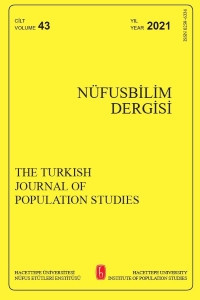EBEVEYN EĞİTİMİNİN DOĞURGANLIK ÜZERİNDEKİ ETKİSİ
Bu çalışma, eğitim ve doğurganlık ilişkisini üç temel soru çerçevesinde incelemektedir. Çalışmanın cevap aradığı soruların ilki, hangi ebeveynin eğitiminin (annenin ya da babanın) ailenin sahip olduğu çocuk sayısı üzerinde, daha belirleyici olduğudur. İkinci soru, bir önceki kuşağın eğitimini dikkate alarak kadının içinde büyüdüğü ailelenin eğitiminin, kadının doğurganlığını nasıl etkilediğini ele almakta, üçüncü soru ise eğitimin doğurganlık üzerindeki etkisinin doğum sırasına göre -ilk çocuğa geçişte, ikinci çocuğa geçişte vb.- farklılık gösterip göstermediğine odaklanmaktadır Çalışmanın veri kaynağı “2003 Türkiye Nüfus ve Sağlık Araştırması”dır. Annenin, babanın, annenin ebeveyninin ve diğer bağımsız değişkenlerin birinci, ikinci ve üçüncü çocuğa geçiş üzerindeki etkisinin ölçülmesinde sağkalım analizi yöntemi kullanılmıştır. Sonuçlar, ilk çocuğa geçişte babanın eğitiminin, sonraki çocuklara geçişte ise annenin eğitiminin daha önemli olduğunu göstermektedir. İkinci ve sonraki çocuklara geçiş hızları annenin ebeveyninin eğitimine göre de farklılaşmaktadır. Bütün doğumlara geçiş hızlarında ebeveyni eğitimsiz olan annelerin doğum yapma olasılıklarının daha yüksek olduğu görülmüştür.
IMPACT OF PARENT’S EDUCATION ON FERTILITY
In this study the relationship between education and fertility is analyzed on the basis of three questions. The first question investigates which of the parent’s education (mother’s or father’s) is more influential on fertility behaviour? Second question takes into account the role of grandparents’ education where women was brought up and asks whether the impact of grandparents’ education have an impact on the fertility of the women. Third question is whether the impact of education on fertility differ by the birth order? Data source of the study is Turkey Demographic and Health Survey-2003. Survival analysis was used to measure the impact of mother’s, father’s, and grandparent’s education and other covariates on the timing of first, second and third births. The findings show that father’s education is more influential on the transition to the first birth, conversely mother’s education is more influential on the timing of the second and third births. The intensity of the second and subsequent births differentiated according to the education of the women’s parent’s education. Women whose parents are uneducated have higher risk of birth at all parities.
Keywords:
Education, Fertility, Survival analysis Event history analysis, Turkey,
___
- Allison, P.D. (1984), Event History Analysis: Regression for Longitudinal Event Data. Newbury Park: Sage Publications.
- Becker, G. (1976), The Economic Approach to Human Behaviour. Chicago: University of Chicago Press.
- Becker, G.S. (1993), A Treatise on the Family (Enlarged edition). Cambridge (Massachusetts): Harvard University Press.
- Blossfeld, H.P. & Rohwer, G. (2002). Techniques of Event History Modeling: New Approaches to Causal Analysis (2nd edition). Mahwah, New Jersey.
- Blossweld, H.P., Golsch, K. & Rohwer, G. (2007), Event History Analysis with Stata. Mahwah, New Jersey.
- Breierova, L. & Duflo, E. (2004), The Impact of Education on Fertility and Child Mortality: Do Fathers really Matter less than Mothers?. NBER Working Paper No. w10513
- Cain, G.G. & Weininger A. (1973), “Economic Determinants of Fertility: Results from Crosssectional Aggregate Data”, Demography, 10 (2), 205-223.
- Cochrane, S.H. (1979), Fertility and Education. What do we really know? Baltimore, Maryland: Johns Hopkins University Press.
- Devlet İstatistik Enstitüsü (DİE). (2001), 2000 Genel Nüfus Sayımı: Nüfusun Sosyal ve Ekonomik Nitelikleri. Ankara.
- Ergöçmen, B.A. (1997), “Women”s Status and Fertility in Turkey”, Fertility Trends, Women”s Status, and Reproductive Expectations in Turkey: Results of Further Analysis of the 1993 Turkish Demographic and Health Survey kitabı içinde bölüm.
- Hacettepe University, Institute of Population Studies (HUIPS) & Macro International Inc. (MI), Calverton, Maryland.
- Eryurt, M.A. (2008), “Türkiye’de Doğurganlığı Belirleyen Ara Değişkenler: Yakın döneme Bakarken”, The Turkish Journal of Population Studies, 27, 67-84.
- Hacettepe Üniversitesi Nüfus Etütleri Enstitüsü (2004), 2003 Türkiye Nüfus ve Sağlık Araştırması. Ankara.
- Hirschman, C. (1994), “Why Fertility Changes”, Annual Review of Sociology, 20, 203-233.
- Hoem, B. & Hoem, J.M. (1989), “The Impact of Women's Employment on Second and Third Births in Modern Sweden”, Population Studies, 43, 47-67.
- Jeffery, R. & Basu, A.M. (1996), “Schooling as Contraception?” Girls’ Schooling, Women’s Autonomy and Fertility Change in South Asia kitabı içinde bölüm. Jeffery, R. & Basu, A.M. (Eds.). New Delhi, Sage, p.15-47.
- Jejeebhoy, S. J. (1995), Women’s Education, Autonomy and Reproductive Behaviour: Experiences from Developing Countries. Oxford, United Kingdom: Clarendon Press.
- Kaplan, E.L. & Meier, P. (1958), “Nonparametric Estimation from Incomplete Observations”, Journal of the American Statistical Association, 53, 457-481.
- Kirdar, M., Dayıoğlu-Tayfur, M. & Koç, İ. (2010), The Effect of Compulsory Schooling Laws on Teenage Marriage and Births in Turkey. Tüsiad-Koç University Ekonomic Research Forum Working Paper Series. Working Paper 1035.
- Köppen, K. (2006), “Second births in western Germany and France”, Demographic Research, 14, 295-330.
- Kreyenfeld, M. (2002), “Time-squeeze, Partner Effect or Self-selection? An investigation into the Positive Effect of Women's Education on Second Birth Risks in West Germany”, Demographic Research, 7, 15-48.
- Mincer, J. (1963), “Market prices, opportunity costs and income effects”, Measurements in Economics: Studies in Mathematical Economics and Econometrics in Memory of Yehuda Grunfeld kitabı içinde bölüm. Christ, C. & others (Eds.). Stanford, California, Stanford University Press.
- Notestein F. 1953, “Economic problems of population change”, Proceedings of the Eighth Int. Conf of Agric. Economists kitabı içerisinde bölüm, p. 13-31. London: Oxford Univ. Press.
- Özel S. & Özden Y.I. (1997), “Evlilikte İlk Doğuma Kadar Geçen Süre ve Bu Süreyi Etkileyebilecek Değişkenlere İstatistiksel Bir Yaklaşım”, III. Ulusal Nüfusbilim Konferansı, HÜNEE, Ankara.
- Population Reference Bureau (PRB). (2010), 2010 World Population Data Sheet. Schultz, T.W. (1973), “The Value of Children: An Economic Perspective”, Journal of Political Economy, 81(2, Pt. 2), S2-S13.
- Tan, J.P. & Haines, M. (1984), Schooling and Demand for Children; Historical Perspectives, Washington D.C. World Bank Staff Working Paper No. 697.
- ISSN: 0259-6334
- Başlangıç: 1979
- Yayıncı: Hacettepe Üniversitesi
Sayıdaki Diğer Makaleler
TÜRKİYE’DE MİLLETVEKİLLERİNİN ÇOCUK SAYISI VE DEĞİŞİMİ: GENEL NÜFUS İLE KARŞILAŞTIRILMALI BİR ANALİZ
EBEVEYN EĞİTİMİNİN DOĞURGANLIK ÜZERİNDEKİ ETKİSİ
Mehmet Ali ERYURT, Banu AKADLI-ERGÖÇMEN
ERKEKLER İÇİN ÇALIŞMA HAYAT TABLOLARI UYGULAMASI: TÜRKİYE, 1980-2000
HAYATİ KAYIT VERİSİNİN KAPSAMINI DEĞERLENDİRMEK İÇİN DOLAYLI DEMOGRAFİK MODELLERİN KULLANILMASI
Ahmet Sinan TÜRKYILMAZ, Erhan Özdemir, İsmet Koç, Oona M.R CAMPBELL
